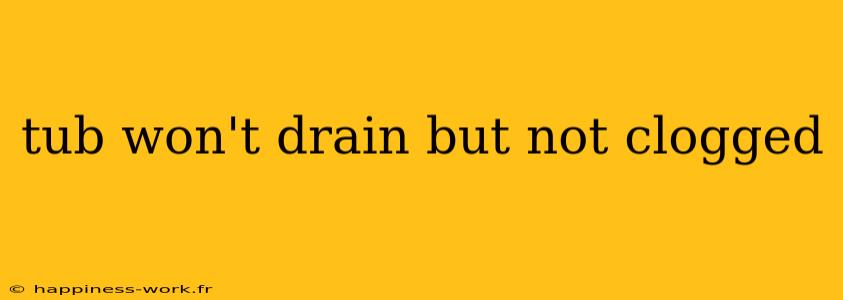Have you ever faced the frustration of a bathtub that won't drain, only to find that it’s not clogged? This problem can be perplexing, leaving you scratching your head and seeking a solution. In this article, we’ll explore common causes of this issue, troubleshooting steps, and practical tips to keep your bathtub draining smoothly.
Understanding the Problem
A tub that won’t drain can indicate various underlying issues, even when there’s no visible clog in the drain. It's essential to identify the problem accurately to apply the correct solution. Here are some potential reasons for this frustrating situation.
1. Slow Drainage Due to Mineral Buildup
Even if you don't notice a clog, mineral deposits from hard water can gradually accumulate in the pipes. This buildup can restrict water flow, causing it to drain slowly or not at all.
Tip: Consider using a vinegar and baking soda solution to break down mineral deposits. Pour one cup of baking soda followed by one cup of vinegar down the drain, let it fizz for about 30 minutes, then flush with hot water.
2. Faulty Drain Stopper or Mechanism
Another possibility is that the drain stopper isn't functioning correctly. If it’s stuck in the closed position or malfunctioning, it can prevent water from draining properly.
Solution: Inspect the drain stopper mechanism. For pop-up stoppers, remove the stopper and clean any debris. Ensure the linkage is correctly connected to allow it to open fully.
3. Ventilation Issues
Plumbing systems rely on proper ventilation to allow air to equalize and water to flow smoothly. If there's a blockage in the vent pipe or the vent is not adequately functioning, it can create a vacuum that prevents drainage.
Action: While this issue may require a professional to inspect, you can check for visible signs of vent blockage on your roof or the area surrounding your plumbing vents.
Step-by-Step Troubleshooting
Step 1: Check for Minor Blockages
While you may feel there’s no clog, it’s best to do a thorough inspection. Use a drain snake to check for hidden obstructions or hair clogs that could be lodged deeper in the system.
Step 2: Inspect the Drain Assembly
Remove the drain cover and check for any visible debris. This can include hair, soap scum, and other residue. Cleaning the drain assembly can sometimes resolve drainage issues.
Step 3: Test the Water Flow
Run water in the tub for a few minutes and observe the draining process. If the water drains slowly, you may have an issue beyond just a simple blockage.
Step 4: Check the P-Trap
The P-trap, which is the curved pipe beneath your tub, is designed to hold water and prevent sewer gases from entering your home. Inspect it for blockages or damage. If it seems clogged, remove it carefully and clean it out.
Step 5: Call a Professional
If your troubleshooting doesn’t resolve the issue, it may be time to call in a plumber. A professional can assess for deeper plumbing issues or venting problems.
Preventive Measures for Smooth Drainage
To help ensure your tub drains properly in the future, consider the following:
- Regular Cleaning: Use a drain cleaner or a mixture of baking soda and vinegar monthly to minimize buildup in your pipes.
- Install a Drain Screen: This simple device can catch hair and debris before they enter the drain.
- Water Softener: If hard water is an issue in your area, consider a water softening system to reduce mineral deposits.
Conclusion
A bathtub that won’t drain is a common annoyance that can often be resolved with a few troubleshooting steps. Understanding the possible causes and knowing how to address them can save you both time and money. By maintaining a clean drain and being proactive about plumbing issues, you can keep your tub functioning optimally.
For more detailed guidelines on plumbing and home maintenance, consider visiting WikiHow and explore the wealth of knowledge available there, created by numerous expert contributors. Remember, when in doubt, consulting with a professional plumber is always a good option to avoid further complications.
Attribution: This article references content from WikiHow and is aimed at providing added insights and practical solutions for the issue at hand. Always ensure the original source is credited in your writings.
